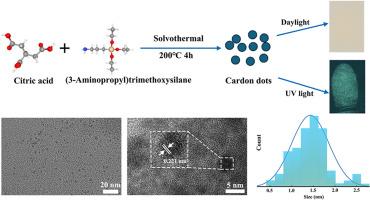Electrostatically functionalized carbon dot powder enables real-time visualization of latent fingerprints with sweat pore-level resolution
IF 4.2
3区 工程技术
Q2 CHEMISTRY, APPLIED
引用次数: 0
Abstract
Fingerprints constitute crucial forensic evidence for personal identification, underscoring the urgent need to develop highly sensitive, rapid, and operationally convenient techniques for visualizing latent fingerprints (LFPs) at crime scenes. This study presents a novel electrostatic-functionalized carbon dots (CDs), enabling real-time visualization of LFP with sweat pore-level (Level 3) resolution. The CDs exhibit bright blue-green fluorescence, uniform size distribution (∼1.5 nm), and exceptional aggregation-resistant solid-state emission through three key advantages: (1) Electrostatic binding mechanism achieving unprecedented sweat pore resolution (20–50 μm pore spacing) on 12 substrates (plastic/metal/paper), surpassing conventional powder methods; (2) Non-destructive interaction preserving >95 % touch DNA integrity for STR analysis; (3) Cost-effective alternative to toxic heavy-metal nanomaterials (Cd/Eu-based), demonstrating 100 % cell viability. The powder shows forensic-grade performance under VSC8000 HS and UV 365 nm, maintaining stability for 6 months. This work advances forensic science by combining high-resolution LFP imaging with DNA preservation in a single-step, eco-friendly protocol.

静电功能化碳点粉使潜在指纹的实时可视化与汗液孔级的分辨率
指纹是个人身份识别的重要法医证据,因此迫切需要开发高灵敏度、快速、操作方便的犯罪现场潜在指纹可视化技术。本研究提出了一种新的静电功能化碳点(CDs),可以实现汗液孔级(3级)分辨率的LFP实时可视化。CDs具有明亮的蓝绿色荧光、均匀的尺寸分布(~ 1.5 nm)和优异的抗聚集固体发射特性,这得益于以下三个关键优势:(1)静电结合机制在12种基材(塑料/金属/纸)上实现了前所未有的汗孔分辨率(20-50 μm孔间距),超越了传统的粉末方法;(2)无损相互作用保存95%的接触DNA完整性用于STR分析;(3)具有成本效益的有毒重金属纳米材料(镉/铕基)替代品,证明了100%的细胞存活率。该粉末在VSC8000 HS和UV 365 nm下具有法医级性能,可保持6个月的稳定性。这项工作通过将高分辨率LFP成像与DNA保存相结合,在单步、环保的协议中推进了法医科学。
本文章由计算机程序翻译,如有差异,请以英文原文为准。
求助全文
约1分钟内获得全文
求助全文
来源期刊

Dyes and Pigments
工程技术-材料科学:纺织
CiteScore
8.20
自引率
13.30%
发文量
933
审稿时长
33 days
期刊介绍:
Dyes and Pigments covers the scientific and technical aspects of the chemistry and physics of dyes, pigments and their intermediates. Emphasis is placed on the properties of the colouring matters themselves rather than on their applications or the system in which they may be applied.
Thus the journal accepts research and review papers on the synthesis of dyes, pigments and intermediates, their physical or chemical properties, e.g. spectroscopic, surface, solution or solid state characteristics, the physical aspects of their preparation, e.g. precipitation, nucleation and growth, crystal formation, liquid crystalline characteristics, their photochemical, ecological or biological properties and the relationship between colour and chemical constitution. However, papers are considered which deal with the more fundamental aspects of colourant application and of the interactions of colourants with substrates or media.
The journal will interest a wide variety of workers in a range of disciplines whose work involves dyes, pigments and their intermediates, and provides a platform for investigators with common interests but diverse fields of activity such as cosmetics, reprographics, dye and pigment synthesis, medical research, polymers, etc.
 求助内容:
求助内容: 应助结果提醒方式:
应助结果提醒方式:


